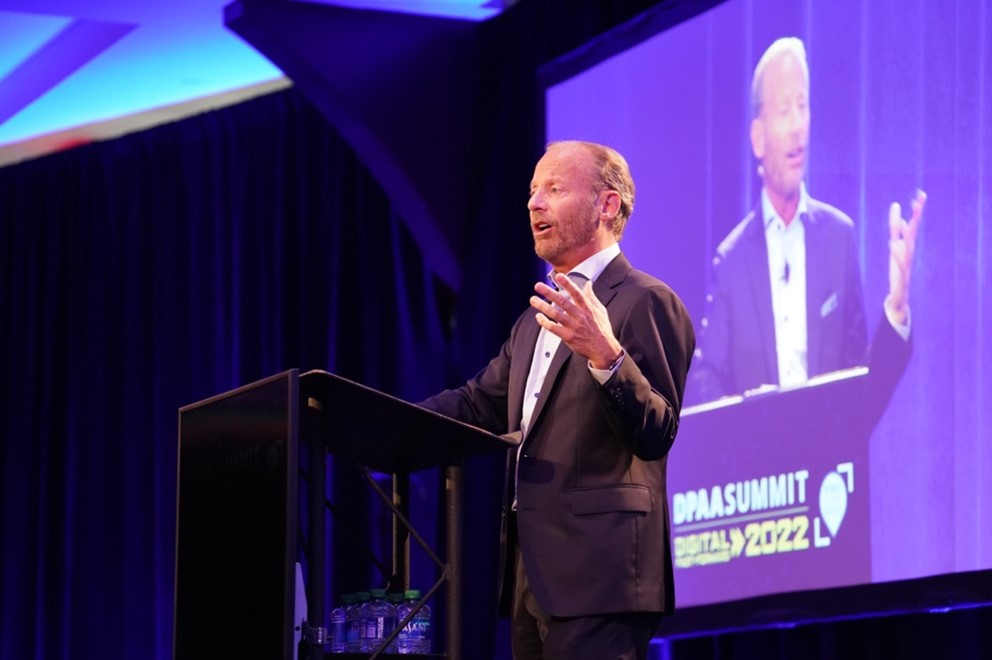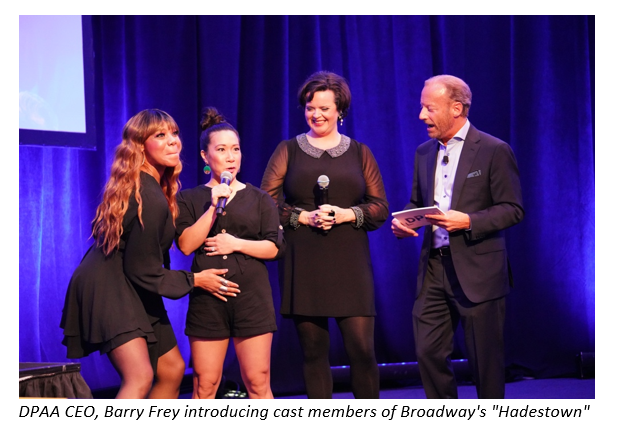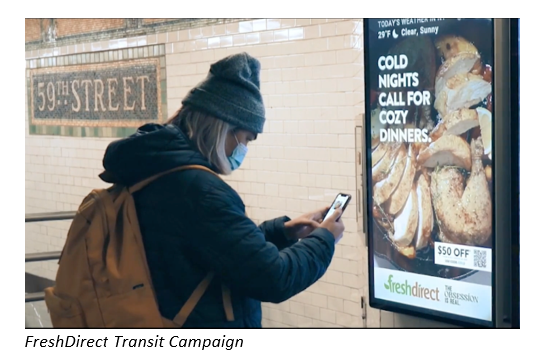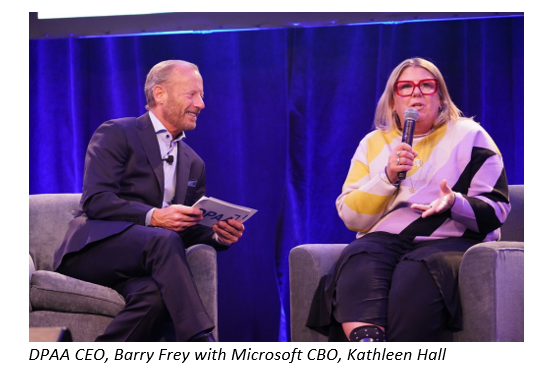Scaling the Summit Using Digital Out of Home

The power of returning to in-person gatherings was made clear when the DPAA -- the trade association for digital out of home advertising -- held its Global Summit again in New York City this past October. The power of the keynote sessions still resonates, especially for those determined to figure out the best places for media buys these days.
The day-long event, which historically pulls in top industry speakers, once again featured leading CMOs -- this time from brands ranging from Yahoo to Uber -- agency CEOs and expert vendors, each offering valuable lessons for our current media environment, including, of course, how they also each incorporate Out of Home advertising (OOH) to reach the right people. While all are available to revisit via the DPAA Summit page, six of those impactful sessions -- from a DTC marketer on up to the No. 4 company among the Fortune 100 -- are summarized here, along with a taste of the very tasteful and at-capacity event.
In Part 1, Fresh Direct, Microsoft and Wolverine explain how they embrace innovative creative, follow the customer and navigate omnichannel storytelling. Part 2 covers how Adidas, Claire's and CVS have approached the Metaverse, the changing retail landscape and generational marketing, too.
The Stars of OOH
After years in the media industry, DPAA CEO, Barry Frey (pictured at top) understands the power of entertainment, so he made sure to surprise and delight the crowd at Chelsea Piers with a special performance by no less than the stars of Broadway hit Hadestown, with songs themed to "how the world could be." Frey leveraged his trademark affability in introducing keynoters at the Summit for compelling conversations that kept the audience "leaning in." The interviews were interspersed with shoulder rubbing among marketing "stars" during coffee and cocktail breaks throughout the day.

Equally impressive in their own way were the presentations by the range of companies, each making it clear how OOH contributes to a successful omnichannel marketing mix for their respective goals. And literally running on the Broadway line and beyond, Fresh Direct showed us how to appeal to busy New Yorkers.
FreshDirect: A leading but regional online grocer, FreshDirect is owned by the larger food retailer, Ahold Delhaize. The brand is familiar to many Northeast residents, and Vice President Brand Marketing, Katie Zapata, shared how FreshDirect fully followed their customers, from underground in the New York subways to their front doors, via shoppable OOH messaging that delivered for its omnichannel marketing strategy.
OOH Having a Moment
The DTC grocer used heavy OOH in a unique way by teaming up with Outfront's "Moments" -- culturally relevant original content themed to different interests and served to different transit digital media formats, reaching millions of daily commuters. FreshDirect's branded integration featured real-time New York City weather conditions paired with different recipe suggestions, for a dynamic campaign across stations and in-car liveboards during key commuting moments.
The OOH content was made shoppable via QR codes that deeply linked customers into a curated shopping experience featuring the recipe ingredients on freshdirect.com.

The results? The trifecta of contextually relevant messaging, branded content and shoppable OOH not only earned attention for FreshDirect via creative that was endemic to New York's irreverent style but increased overall customer acquisition and consumer engagement throughout the campaign.
Per Zapata, "Many would assume that digital would be the way to go for us as a digital company. But we need all the channels to work together, so Out Of Home is really an important part of our mix -- especially here in New York City, where we're always on the go."
They didn't stop in their tracks though. Since Zapata also credits OOH with driving 7x more social activations than other media per dollar spent (Comscore), they connected the dots from a social media comment about a recipe to an IRL surprise delivery to that customer, adding good PR to the campaign ingredients.
Microsoft: Illustrating how a global brand can benefit from OOH on a regional level, Microsoft Chief Brand Officer, Kathleen Hall, walked the Summit audience through how she keeps things personal at scale and embraces innovation in leveraging digital out of home.
Marketing Through Complexity
In introducing Hall, Frey applauded Microsoft's recent Cannes Lions Creative Marketer of the Year win and acknowledged the complexity that must go hand in hand with marketing such a massive brand. "It's kind of mind-boggling," Hall admitted, "especially when you consider our old choices were just about the media mix. Now exponentially layer on top of that your measurement opportunities … and the matrix of options you need to consider in designing a marketing plan … But my agencies are totally attuned from day one on the business outcome we're trying to drive to. Then things fall away as you follow that true north."

Part of that direction is to include OOH in the omnichannel mix, especially for its brand-safe offering. “It’s a very sensitive environment right now, so it’s very difficult to thread the needle both on messaging and on tone without offending someone somewhere.” But the magic, as Hall calls it, happens when you can “align the social movement or trend with the brand truth – or values.”
A brand truth for Microsoft? Innovation. Hall wove in the example of how they launched Surface and Windows 8 exactly ten years ago with the first-ever Times Square takeover. "You have to think big," she said. "All the digital boards were linked to work together to act as a giant touchscreen. When we saw all of those Times Square boards light up and just the bigness and power and community? There's something about that communal experience …"
In a low tech but "personal" touch using out of home, when Microsoft launched Surface they gained consumer attention and ad community recognition for creating chalk painting messages on sidewalks … "and then the Survival billboard [for Xbox/Tomb Raider using live humans and earning multiple awards], which is one of the best examples of creative …" The industry needs to keep doing things like this!
Wolverine Worldwide: Ben Aronson is Vice President Consumer Marketing for a billion-dollar portfolio of 13 trusted and beloved brands ranging from Merrell's to Keds. He and Meghan Grant, President, US Media, Havas Media, discussed what a holistic marketing plan looks like and what media channels unlock the right results for the lifestyle and apparel company. Ultimately the goal, Aronson said, was to connect marketing and media "to that meaningful nature of what is a brand (a representation of our feelings about it) and all the products and categories you can fulfill within that… but it all should be omnichannel and channel agnostic to a certain extent. Looking at it truly holistically builds better results."
Innovative Vs. Iconic: The Challenge For Meaningful Mindshare
The challenge of things being omnichannel, Grant added, is that it "has to be balanced with trying to capture audiences who are bombarded with more messages than they've ever been bombarded with in their entire lives." So how do you balance brand fidelity and the ethos, with things that are channel specific?
Echoing Hall's refrain about today's complexity in media and marketing choices, Aronson said, "It used to be media and marketing got the brief to work on together. Then I needed a social campaign. Then I needed a TikTok campaign … by tomorrow … What we need to do more often is say I'm not answering that TikTok brief if we don't have a social strategy … I realize TikTok matters to you, and it might matter to your audience, but doing an innovative thing for a moment does very little to build a lasting brand."
So how is Wolverine building meaningful mindshare? Through consistency. "Iconic brands are not iconic because of random tactics but because of consistent and repeated behaviors building towards a specific sense of emotion and perception of the brand over time," Aaronson noted. While that seems self-evident, Wolverine sets up structures that can ensure consistency, especially in an era when brands have an average of seven different agencies.
"Do we all understand what an audience segmentation is supposed to look like?" he asked. "That audience segmentation should influence every agency the same way? … Then a brand like Merrell, our biggest brand, can flex into channels that other brands can't, or do something different than a smaller brand like Keds can do. But it's rooted in a foundation of rigor and operational structures that provide for consistency. It's not sexy talking about who gets to sign off on what or having brand guidelines that actually means something, but that is how great brands are built and how iconic brands are built."
Linking Media And Creativity
"Creative agencies fly to the South of France and drink a lot of champagne when our creative is interesting, but we never saw the hard number business results," Aronson quipped with seriousness. "On the media side we have access to far more data that informs our decision making ... and now, when you have a 20 channel plan and know Instagram is different from LinkedIn and a national out of home plan is different than a regional, my perspective is everything should actually start with your media strategy (after you have your brand principles and your audience.)"
The reason, he explained, is that "your creative agencies should know where everything needs to run, and what metrics it's being measured against before they develop a creative idea. It's like the saying, 'Give me the freedom of a tight brief.' It will be better and more effective versus using the excuse that, 'Oh, that creative was never really meant for here.'"
The Place for Out of Home
Aronson explained the appeal of OOH as part of Wolverine's plan. "For somebody whose job is technically to drive the digital and DTC growth of our company, I'm oddly bullish on out of home," he said. "The outdoor space really is a full funnel, even if it is a traditional funnel. The fact that it's actually addressable now, and it really is that sort of last bastion of true viewability, makes it, I think, incredibly special and I think a place where those opportunities for the magic of creative and media to come together makes it a great place to start.
"Out of home placements are almost like retail spaces in the sense that they can give a premium nature to a brand," he continued. "There is scale that impacts us mentally and emotionally in ways that digital which, is so small, just doesn't do. And we've seen statistical studies that lift awareness and perception metrics tied to OOH. For some people that ad on Thompson Street will be an awareness ad because they're not in shopping mode. But for other people it's going to be a conversion ad as a last second reminder to go buy. That's massively interesting about OOH and its proximity power to the stores where you are."
In Part 2, Moss covers the takeaways from marketing leaders ofAdidas, Claire's and CVS.
Click the social buttons to share this story with colleagues and friends.
The opinions expressed here are the author's views and do not necessarily represent the views of MediaVillage.com/MyersBizNet.


